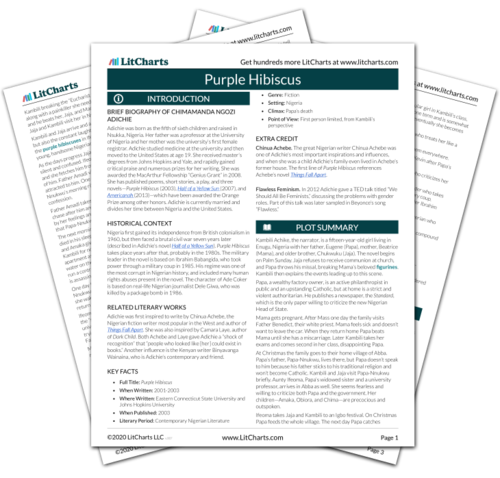Author: Chimamanda Ngozi Adichie | Submitted by: Maria Garcia | 38721 Views | Add a Review
Few books are only available in 'with images' version.
The Purple Hibiscus Book Pdf
BREAKING GODS
- Free download or read online Purple Hibiscus pdf (ePUB) book. The first edition of the novel was published in October 30th 2003, and was written by Chimamanda Ngozi Adichie. The book was published in multiple languages including English, consists of 307 pages and is available in Paperback format. The main characters of this fiction, cultural story are Kambili, Jaja. The book has been awarded.
- Symbolism in Adichie’sPurple Hibiscus Pintu Karak M.A in English The University of Burdwan West Bengal India Abstract One of the central figures in Nigerian literature,Adichie makes herself popular through the publication of her debut novel Purple Hibiscus (2003) which is a highly symbolical novel.
Purple Hibiscus Book Pdf
Palm Sunday
Read Online Purple Hibiscus A Novel and Download Purple Hibiscus A Novel book full in PDF formats. PDF EPUB Download. Books cram the shelves. Download Free Purple Hibiscus P S Purple Hibiscus P S Getting the books purple hibiscus p s now is not type of inspiring means. You could not unaccompanied going following book store or library or borrowing from your connections to right of entry them. This is an entirely simple means to specifically acquire guide by on-line. Download Purple Hibiscus PDF/ePub or read online books in Mobi eBooks. Click Download or Read Online button to get Purple Hibiscus book now. This site is like a library, Use search box in the widget to get ebook that you want. If the content Purple Hibiscus not Found or Blank, you must refresh this page manually or visit our sister site Purple.


Things started to fall apart at home when my brother, Jaja, did not go to communion and
Purple Hibiscus Book Download Pdf
Papa flung his heavy missal across the room and broke the figurines on the étagère. We had just returned from church. Mama placed the fresh palm fronds, which were wet with holy water, on the dining table and then went upstairs to change. Later, she would knot the palm fronds into sagging cross shapes and hang them on the wall beside our gold-framed family photo. They would stay there until next Ash Wednesday, when we would take the fronds to church, to have them burned for ash. Papa, wearing a long, gray robe like the rest of the oblates, helped distribute ash every year. His line moved the slowest because he pressed hard on each forehead to make a perfect cross with his ash-covered thumb and slowly, meaningfully enunciated every word of “dust and unto dust you shall return.”
Papa always sat in the front pew for Mass, at the end beside the middle aisle, with Mama, Jaja, and me sitting next to him. He was first to receive communion. Most people did not kneel to receive communion at the marble altar, with the blond lifesize Virgin Mary mounted nearby, but Papa did. He would hold his eyes shut so hard that his face tightened into a grimace, and then he would stick his tongue out as far as it could go. Afterward, he sat back on his seat and watched the rest of the congregation troop to the altar, palms pressed together and extended, like a saucer held sideways, just as Father Benedict had taught them to do. Even though Father Benedict had been at St. Agnes for seven years, people still referred to him as “our new priest.” Perhaps they would not have if he had not been white. He still looked new. The colors of his face, the colors of condensed milk and a cut-open soursop, had not tanned at all in the fierce heat of seven Nigerian harmattans. And his British nose was still as pinched and as narrow as it always was, the same nose that had had me worried that he did not get enough air when he first came to Enugu. Father Benedict had changed things in the parish, such as insisting that the Credo and kyrie be recited only in Latin; Igbo was not acceptable. Also, hand clapping was to be kept at a minimum, lest the solemnity of Mass be compromised. But he allowed offertory songs in Igbo; he called them native songs, and when he said “native” his straight-line lips turned down at the corners to form an inverted U. During his sermons, Father Benedict usually referred to the pope, Papa, and Jesus—in that order. He used Papa to illustrate the gospels. “When we let our light shine before men, we are reflecting Christ’s Triumphant Entry,” he said that Palm Sunday. “Look at Brother Eugene. He could have chosen to be like other Big Men in this country,
Book With Images - Best Experience on Desktop

Comments
Share your Thoughts for Purple Hibiscus